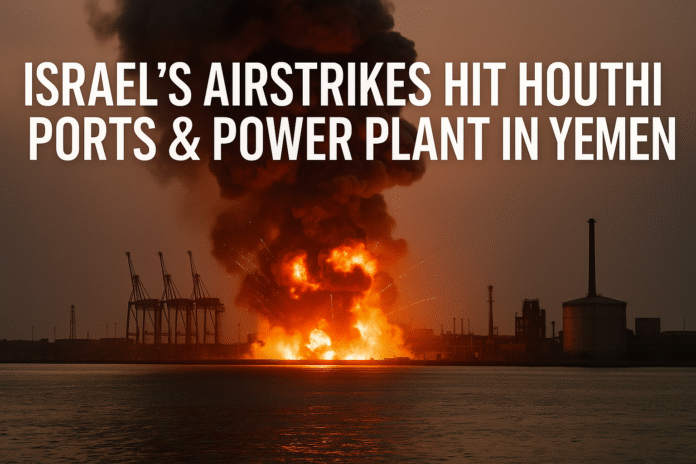1. What Happened
On July 6–7, 2025, Israel launched airstrikes on three Houthi-held Yemeni ports—Hodeidah, Ras Isa, and Salif—along with the Ras Qantib power plant, according to the Israeli military reuters.com+5reuters.com+5timesofindia.indiatimes.com+5en.wikipedia.org+15thetimes.co.uk+15timesofindia.indiatimes.com+15. The Galaxy Leader vessel, seized by Houthis in late 2023, was also hit for allegedly serving as a maritime surveillance node aljazeera.com+11apnews.com+11thetimes.co.uk+11.
2. Why Israel Struck Now
Just hours earlier, a Greek-owned, Liberian-flagged cargo ship named Magic Seas was attacked in the Red Sea, reportedly by Houthi rocket drones—forcing the crew to flee as the vessel took on water news.sky.com+4ft.com+4apnews.com+4. Although no group claimed responsibility, the method matched Houthi tactics, including RPGs and drone boats aljazeera.com+15ft.com+15apnews.com+15.
In response, Israel cited repeated Houthi attacks as justification for its strikes en.wikipedia.org+14apnews.com+14thetimes.co.uk+14.
3. Scope of the Strikes
The IDF specifically targeted:
- Hodeidah, Ras Isa, Salif port facilities
- Ras Qantib power plant
- The Galaxy Leader vessel, now suspected of radar use news.sky.com+4timesofisrael.com+4abc.net.au+4en.wikipedia.org+15reuters.com+15reuters.com+15
Israeli Defense Minister Kuskat warned, “Anyone who raises a hand against Israel will have it cut off,” and vowed further action if needed apnews.com+1timesofisrael.com+1.
4. Houthis’ Immediate Response
The Houthis confirmed their air defenses intercepted Israeli jets over Hodeidah and claimed many missiles failed politico.com+15thetimes.co.uk+15aljazeera.com+15. Shortly after, they launched two missiles toward Israel. Sirens blared in Jerusalem, the Dead Sea region, and Hebron—but no injuries or damage were reported aljazeera.com+1timesofisrael.com+1.
5. Why These Ports & the Power Plant Were Struck
Israel alleges that:
- The struck ports serve as Iranian arms supply routes, facilitating weapon transfers to Houthis x.com+11apnews.com+11aljazeera.com+11
- The Galaxy Leader ship was used to install a radar system for maritime targeting news.sky.com+11thetimes.co.uk+11telegraphindia.com+11
- The Ras Qantib plant fueled Houthi military operations x.com+15apnews.com+15timesofindia.indiatimes.com+15
This expands Israel’s strikes beyond Gaza’s perimeter into Yemen’s supply chains en.wikipedia.org+15politico.com+15news.sky.com+15.
6. How This Fits Into the Broader Conflict
Since October 2023, the Iran-aligned Houthis have launched missile and drone strikes against Israeli and commercial vessels in solidarity with Gaza aljazeera.com+9reuters.com+9abc.net.au+9. Over 100 ships have been targeted, disrupting global trade through the Red Sea corridor reuters.com+9apnews.com+9apnews.com+9.
Israel and the U.S. have previously shelled Houthi positions—including the May and June navy strikes, and operations in December 2024 en.wikipedia.org.
7. Civilian Impact & Evacuations
Before launching, the IDF issued evacuation warnings for the targeted ports and power plant en.wikipedia.org+10timesofisrael.com+10news.sky.com+10. Local reports stated the power plant shut down, plunging Hodeidah into darkness—but there were no immediate reports of casualties en.wikipedia.org+11reuters.com+11thetimes.co.uk+11.
8. Global Reactions & Escalation Risk
- U.S. naval forces have remained in the area but have not joined the strikes—Israel acted unilaterally .
- Observers warn this escalation risks dragging in Western navies—already active near Houthi targets in March .
- The strikes surged amid delicate Gaza ceasefire discussions and renewed U.S.–Iran nuclear tensions politico.com+1apnews.com+1.
This adds another volatile layer to an already multi–front crisis.
9. Historical Context: Past Israeli Strikes
Israel previously launched large-scale strikes:
- December 2024 (“Operation White City”): multiple ports, power stations, airport—~15 dead en.wikipedia.org+1reuters.com+1en.wikipedia.org+2en.wikipedia.org+2en.wikipedia.org+2
- 29 Sept 2024: Port of Hodeidah hit, 6 killed, 57 injured en.wikipedia.org
- May–June 2025: Multiple strikes including naval attacks at Hodeidah in May 2025 en.wikipedia.org
Thus, Sunday’s strikes resume a pattern of strategic targeting of Houthi logistics.
10. Impacts on Red Sea Trade & Shipping
The Red Sea corridor is critical—handling almost US$1 trillion in maritime trade annually aljazeera.com+15apnews.com+15timesofindia.indiatimes.com+15. The new strike and ship attack raises global seabed worries and may prompt insurers to reroute vessels around Africa, increasing time and cost .
11. What Could Happen Next
- Further missile fire from the Houthis is likely, testing Israel’s deterrence.
- Western navies (U.S., UK) may increase patrols or intervene if civilian vessels are threatened.
- A broader regional military campaign could emerge if escalations continue, possibly linking with Gaza and Iran fronts.
- Ceasefire negotiations may stall further as Israel opens a new front en.wikipedia.org+12politico.com+12timesofisrael.com+12.
The next steps are critical and could shape regional balance.
12. Key Players & Strategic Timeline
- Israel: Using long-range strikes to protect shipping and counter Houthi threats.
- Houthis: Iran-backed proxy, resisting through missiles and naval drones.
- U.S. & UK: Quietly involved; past involvement in March 2025.
- International firms: Shipping companies must reroute or accept higher risk.
Timeline summary:
- May–June 2025: Israel strikes via Navy/air in Hodeidah
- July 6: Houthi-attack on Magic Seas
- July 6: Israeli airstrikes hit ports & power plant
- July 7: Houthi missiles fired; tense stand-off
🔚 Conclusion
In sum, Israel’s July strikes in Yemen mark a significant escalation—directly targeting Houthi logistics hubs tied to Iranian support. This comes after a direct maritime attack in the Red Sea. Israel’s unilateral action risks drawing in broader naval actors and stalling diplomatic efforts, just as Gaza ceasefire talks loom.
Globally, Red Sea trading ships may divert routes; regionally, confrontation may expand. The coming days will tell if this sparks further escalation, an international naval build-up, or renewed diplomatic pressure.




